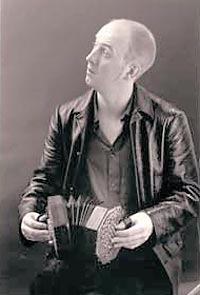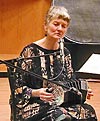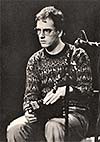How did your technique come about?
I think it came right from the start when Edinburgh player Tom Ward got me the 48 key
wooden ended Lachenal. He didn't teach, but he gave me a copy of Alistair Anderson's
beginners instruction book "Concertina Work Shop" and I taught myself from there. As
far as I can remember, there were no pictures in the book to show how the instrument
should be held, so, instead of holding it straight down with the buttons going horizontal
to my leg in what I later learned was the conventional manner, I started off holding it at
an angle of 90 degrees so my hands were quite far up. Six months later, when I got my 56
key Wheatstone Æola, I got into the habit of holding it with my hands at 45 degrees,
probably because it was a heavier instrument. Also, I decided to not use the pinky holders
because I felt that it was really restrictive and stopped me getting down to the notes.
Nowadays I still hold the concertina at around 45 degrees, and with the thumb straps
loosening over time and being really wide, I can move my hands up and down the key
board instead of just my fingers. As a result, I can play right down the bottom end of my
56 key instrument with my index and middle fingers. I don't use my third finger that
much on the left-hand side of the concertina. I think this came about as the result of
constantly practicing "rolls" with only my index and middle fingers. I do use my third
finger if I'm playing an F natural to F sharp (that's the F's above middle C on the left
hand). I'll use the middle finger to the third finger for a grace note. But other than that, if
I'm not doing some sort of chromatism, I find not using the third finger a really good
thing, because it doesn't get in the way. Of course, I do use the third finger if I'm doing
chords, but that's a different thing entirely. My right hand is using normal fingering,
i.e.using all three fingers. Although, if I'm doing a roll on the far right, I would still use
my index and middle finger, But that's more out of laziness because I never spent time
working out my rolls on my middle and third finger. What I find about the conventional
technique of the concertina going parallel with the leg is that it really restricts getting
down to the lower notes quickly. And the whole thing of having to bend the index finger
right down to the bottom notes of the instruments is very hard to do. Basically, my
technique works for me insofar as it gives me greater flexibility and full command of the
keyboard.
What has come out of using this technique?
When I was very young, I remember going along to a workshop taken by Scottish
concertina player Norman Chalmers. He was talking about concertina players who do
"rolls" just using their index and middle fingers. It was the first time I had heard this and
it fascinated me. I think he was actually talking about Anglo players but I misheard and
took the idea home to start work on. It is now quite at the centre of my technique. It is
very rhythmical and gives me a choice of different styles. It can be legato or staccato and,
it is great for playing rhythms.
I am particularly interested in lightness of playing. When I play my bellows I will get in 8
octaves of G, up and down on the one bellow without loss of clarity. I think this is
because I have worked hard to develop very good bellows pressure. I feel the bellows
pressure in my left hand (I hold the concertina on my right knee and I pull out with my
left hand) and I would describe my control of the bellows as very steady and very light.
I'm not really into bellows shakes because I feel it takes away a bit from the player's
control of the instrument. For example, pulling out the bellows, the control is in the left
hand and not in the bellows. I can play fast or slow, accelerate or decelerate, always being
in total control of what's going on. It is very effective in, for example, slow airs or adding
vibrato. It's all about bellows work.
I am often asked about octave playing. It is one of the things I've developed in my
playing to allow me to get different sounds. If I am playing in a scale of G starting above
middle C on the left hand, I can play the octave below (at the same time) all the way up
and down without thinking about it . Basically my right hand is mimicking what the left
hand does (and vice versa). In other words, anything that I do in the middle octave around
middle C, I can duplicate with the other hand. So, if I'm playing in a scale of A major I
find it very easy to play the octave above or below without thinking about it - the hand
just seems to go there. Working in inverse (as it seems) does not perhaps sound obvious
or natural, but in a way that's not what's happening, because the hands are still moving in
the same direction. It gives a very nice effect as well—using bellows control and a little
bit of vibrato moving up the scale and octaves in intervals of thirds and fifths. Also, the
octave thing can be in any interval, so moving up the keyboard in thirds or sevenths or
flat ninths or whatever, is actually quite fun.
When I was very young my dad played a lot of jazz in the house and I was very interested
in making my music swing. To get the effect I was looking for, I started to "dot"
everything, like a fast hornpipe. Then, through listening to musicians like Louis
Armstrong, The Hot Five, and Johnny Dodds etc. it came to me how to swing the music.
Swing exists on the second and fourth beats of the bar, unlike a lot of traditional music
which is played on the first and third beats. So now, when I play a reel, I'm quite
conscious that I'm playing the rhythm on the second and fourth beat (which is termed as
playing on the up beat of the bar). I'm controlling this with the bellows—playing little
pushes and pulls.
The other thing about my technique is that it allows me to play very fast—while not
sounding too fast(!). There are so many fast tunes and jigs as well as the beautiful slow
airs in the celtic repertoire (as you will hear on my CD The Big Day In), so to be able to
play them requires good technique and loads of practice.
Where are you now with your concertina playing?
A few years ago I went to Amsterdam to play with some Dutch jazz musicians who were
into free improvised music bigtime. Amsterdam is one of the main places in Europe for
improvised music. This facinated me! At our first gig a trombone player called Joost Buis
who owned an Anglo concertina said to me, "do you want to do a concertina duet?" I
was trying to think what tunes we could do together but he just sat down and started
making all these strange noises—I loved it immediately! So I started tapping the keys and
things, note clusters and noises. I loved the ideas, the lack of constraint. I just took to it
immediately and its now a part of my playing. Sometimes, during solo gig, I will start
freely improvising and see what happens (removing notes and experimenting?!).
I love sound and am very interested in space. The most fantastic musician I have ever
heard is pianist Micha Alperin, who plays with the Moscow Art Trio. He says that
music's all about the performance—whatever happens in the performance is just a
microsecond so, if you play it wrong, it doesn't matter at all because it's part of the
performance and it could take you on a whole new road to where your set of tunes is
going. I find that concept great fun.
I am very interested in chords. On my 56 key concertina it's great as it's a tenor treble and
it goes down to the low middle C (a fifth below the 48 key concertina). But, on the
bottom left corner where it should be a D sharp it has a B flat. I try to use all my fingers
for chords and I like to experiment with the sounds. I do like my bass notes on the
concertina but don't allow them to take over the whole instrument. In performance, I use
acusound pick-ups which are very good. They go at the top and
are specially made for concertinas. (I'll write about this another day!)
I don't know where I will be going next with my style. I feel that I am still going through
my experimental stage. Something I could do a bit more often is tune my concertina. My
E goes flat all the time because in Scottish music, we play with fiddlers in the key of A
much of the time so it's a note that gets quite a lot of playing.
This article originally appeared at
www.footstompin.com
and is reproduced here with permission of its author, Simon Thoumire.
Author
Simon Thoumire
(
)
from Edinburgh, Scotland started his musical career at the age of eight
playing Highland bagpipes. He got his first concertina when he was twelve after being
attracted to the instrument through the playing of Hamish Bayne of Scottish folk band
"The McCalmans". Read more about Simon at www.simonthoumire.com.
Have feedback on this article?
Send it to the author.
Reprinted from the Concertina Library
http://www.concertina.com
© Copyright 2000– by Simon Thoumire




